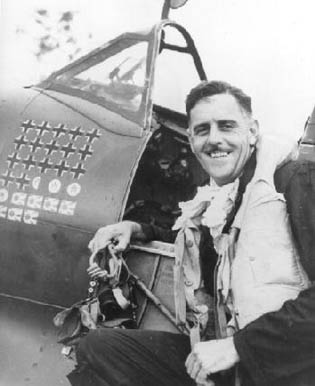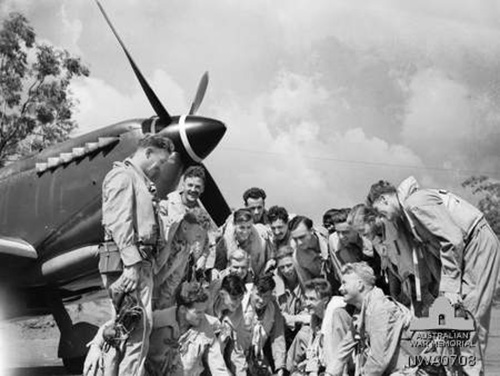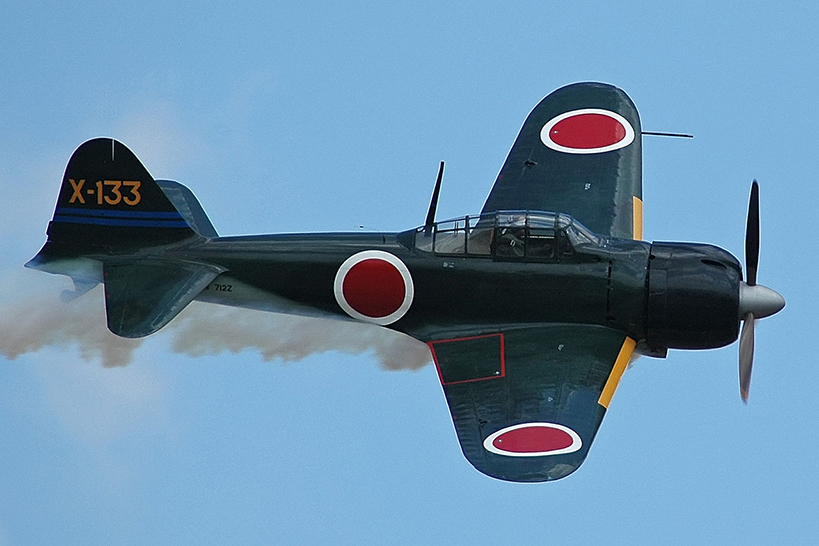Caldwell, Clive Robertson "Killer"
- Date of birth:
- July 28th, 1911 (Lewisham, New South Wales, Australian)
- Date of death:
- August 5th, 1994 (Sydney, Australian)
- Nationality:
- Australian (1901-present, Federal Monarchy)
Biography
Clive Caldwell was born in Lewisham, region Sydney on 28 July 1911. He began his flying career in 1938 when he joined the Aero Club of New South Wales. Nevertheless, by the time the Second World War began he had logged only 11 hours of solo flying. He was 29 years old when he joined the Empire Air Training Scheme, completing the entire course in Australia and graduating as a pilot in January 1941.
Caldwell was sent to the Middle East and posted to No. 250 Squadron, RAF. The squadron flew P-40 Tomahawks and after a short period flew operations in Syria and Cyprus, the squadron was relocated to North Africa. It was in this theatre that Caldwell achieved great success during intensive operations. On 26 June, 1941 Caldwell scored his first victory, against a Messerschmitt BF 109. After that his score mounted rapidly and he became known for practicing gunnery against the shadow of his own aircraft over the desert. This became a method allowed for the assessment of required deflection to hit moving targets. On 29 August 1941 Clive Caldwell was attacked by two Bf 109s North-West of Sidi Barrani and got wounded. Despite damage to both himself and the aircraft, Caldwell turned on his attackers and sent down one of the Bf 109s in flames. The pilot of the second Messerschmitt made off in some haste. Caldwell's engine had caught fire, however he managed to extinguish the flames with a violent slip and nursed his flying wreck back to base at Sidi Haneish. Caldwell's most successful day was 5 December, 1941 when he shot down five Junkers Ju-87s (Stuka) in a single engagement during operation "Crusader".
When his score had reached 17 enemy aircraft, he was promoted to Squadron Leader in January 1942 and transferred to take command of No. 112 Squadron, RAF. By the time he joined them, the squadron was equipped with the already famous ‘sharkmouth’ P-40 Kittyhawks fighters. It was due to his leadership, confidence and daring, his work with many Polish pilots attached to No. 112 Squadron, and continued success with this squadron that he received the Polish Cross of Valour.
With Japan having entered the war, experienced airmen were needed at home. The Australian government asked that he be released to return to Australia to command a Wing in the defence of Australia. Caldwell left the Middle East with nineteen individual and three shared confirmed enemy kills, six probables, and fifteen damaged. Before returning home he spent some time with the Kenley Wing in England to gain experience on Spitfires. On 26 November, 1942, Caldwell was made Wing Leader of No. 1 Fighter Wing. This Wing was to consist of 3 Squadrons of Spitfires and known as the "Churchill Wing" which comprised of No. 452, No. 457 RAAF and No. 54 Squadron RAF. No. 1 Fighter Wing arrived in Darwin on 15 January, 1943 and the unit was equipped with Spitfire Vc Trop. code named "Capstan". The wing flew operations over northern Australia and was involved in the defence of Darwin. On 2 March, 1943 he claimed his first Japanese victory while leading a flight of 6 Spitfires on patrol. Just beyond landfall, he spotted 6 Kate dive-bombers escorted by 12 Zero fighters preparing to attack allied shipping in the Arafura Sea just north of Darwin. The 5 Spitfires followed their leader and attacked and repelled the intruders, but not before Caldwell destroyed 1 Zero fighter and 1 Kate dive-bomber. In August, having raised his tally with eight Japanese aircraft to 28.5, he was awarded the Distinguished Service Order and was posted to No. 2 Operational Training Unit as Chief Flying Instructor.
In May 1944 Caldwell returned to an operational posting, being appointed Wing Leader of No. 80 Fighter Wing. This unit included No. 79, No. 452 and No. 457 Squadrons which were equipped with the Spitfire Mk VIII and was based in Morotai but was employed in a ground-attack rather than a fighter role. For Caldwell and other fighter pilots, this meant the chance to increase his score had passed. By the end of 1944, having been left out of the main battle, RAAF pilots in the Pacific were aggrieved at having to fly dangerous — but in their eyes — unimportant operations against heavily defended ground targets. With nothing having been done to meet the pilots’ concerns, Caldwell and other senior officers resigned in protest, the so-called Morotai mutiny. This action lead to a command crisis in the RAAF. An investigation resulted in two senior officers being relieved of their appointments. Caldwell and the other officers that had resigned were cleared and each was reinstated. Caldwell finished the war attached to HQ, 1st TAF, RAAF, based in Melbourne. He resigned from the RAAF on 1946.
After the war Caldwell went into business. His effectiveness as a fighter pilot had earned him the nickname "Killer". Though the name stuck, it brought him no pleasure. Caldwell was the highest scoring RAAF pilot of the Second World War. He died on 5 August 1994 and was cremated.
Do you have more information about this person? Inform us!
- Period:
- Second World War (1939-1945)
- Rank:
- Flight Lieutenant
- Unit:
- No. 250 (Sudan) Squadron, Royal Air Force
- Awarded on:
- December 26th, 1941
"This officer, it is stated, has performed splendid work in the Middle East operations. He has at all times showed dogged determinations and high devotion to duty which have proved an inspiration to his fellow-pilots. On one occasion, during a patrol, he was attacked by two
Me. 109's. His aircraft was badly damaged, while he himself reiceived wounds on his face, arms and legs. Nevertheless, he conrageously returned to the attack and shot down one of the hostile aircraft."
- Period:
- Second World War (1939-1945)
- Rank:
- Flight Lieutenant
- Unit:
- No. 250 (Sudan) Squadron, Royal Air Force
- Awarded on:
- December 26th, 1941
"This officer continues to take his toll of enemy aircraft. One day in December, 1941. Fit. Lt. Caldwell led his flight against a number of Junkers 87s, and during the combat he personally shot down five of the enemy aircraft, bringing his total victories to 12."
Second decoration as a bar on the ribbon of the first.
- Period:
- Second World War (1939-1945)
- Rank:
- Squadron Leader
- Unit:
- No. 112 Squadron, Royal Air Force
- Awarded on:
- August 2nd, 1942
- Period:
- Second World War (1939-1945)
- Rank:
- Wing Commander
- Unit:
- No. 1 Fighter Wing, Royal Australian Air Force
- Awarded on:
- October 14th, 1943
"'Wing Commander CALDWELL, on completion of his flying training in January 1941, was posted overseas, served with much distinction and was credited with the destruction in combat of 20 1/2 enemy planes. He returned to Australia in September 1942, and was subsequently posted to No.1 Fighter Wing where by his confidence, coolness, skill and determination in the air, he has set a most excellent example to all pilots in the wing. His skill and judgment as a leader are outstanding. On 2nd March, 1943, he led a formation of six fighters against a force of enemy fighters and bombers totalling twice that number, and was responsible personally for destroying two. On 2nd May, 1943, when leading the wing against a large number of enemy raiders, he again personally shot down and destroyed two enemy aircraft. On 20th June, 1943, during an attack by enemy raiders, through failure of his radio, he was obliged to hand over the lead of the wing, as he was unable to receive directions from Sector control. In spite of this however, he searched for and found a portion of the raiding force and succeeded in shooting down one of the enemy. Wing Commander CALDWELL has flown over 475 active operational flying hours and has carried out over 300 operational sorties. His personal score of enemy aircraft destroyed in combat has now passed twenty five, five of which are Japanese shot down since his return to Australia. His courage, determination, skill and his undoubtedly outstanding ability as a leader are an inspiration to his wing and worthy of the highest praise."
- Period:
- Second World War (1939-1945)
- Period:
- Second World War (1939-1945)
- Period:
- Second World War (1939-1945)
- Period:
- Second World War (1939-1945)
- Period:
- Second World War (1939-1945)
- Period:
- Second World War (1939-1945)
Sources
- Photo 1: RAAF Museum
- - Third Supplement to The London Gazette Issue 36215 published on the 15 October 1943
- Flight Global - Archive
- Australian War Memorial
- Digger History
- Elknet.pl
- Australian War Memorial













